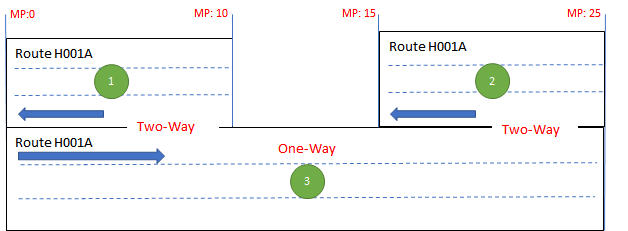Setup & Concept
Network_Lanes_Count table contains information about the number of lanes in each direction for all routes within the system. It is a very simple table containing only 2 columns, LOC_IDENT (the reference to each locations data in SETUP_LOC_IDENT), and NUMBER_OF_LANES, which is a count of the number of lanes in the associated direction. The one caveat about this table is that all associated records in the SETUP_LOC_IDENT table (WHERE SOURSE_TABLE='NETWORK_LANES_COUNT') must be direction specific, meaning the LANE_DIR column will not be 0 for any referenced location in this table.
NETWORK_LANES_COUNT Structure
Column Name | Pk | Null? | Data Type | Comment |
|---|---|---|---|---|
LOC_IDENT | N | INTEGER | Location Reference Link | |
NUMBER_OF_LANES | Y | INTEGER | Number of lanes over specific section |
The figure below presents shows a hypothetical scenario that can be used to understand how information about the route directions stored in Network_Lanes_Count. The figure further dissects the example presented in the NETWORK_LINE_DIRECTIONS section above. For the route H001A, we are now looking at the number of lanes on the undivided highway, that is two-way for a certain portion and one-way for a small portion. It is useful to define the LRS this way if, users will be able to record events on the lanes in each direction.
In order to capture the network setup shown in figure above, there will be 3 records added to the SETUP_LOC_IDENT table, corresponding to source table Networkk_Lanes_Count.
| Record | LOC_IDENT | ROUTE_ID | LANE_DIR | LANE_ID | OFFSET_FROM | OFFSET_TO | SOURSE_TABLE |
|---|---|---|---|---|---|---|---|
| 1 | 71298351 | 1145 | 2 | 0 | 0 | 10 | NETWORK_LANES_COUNT |
| 2 | 71298352 | 1145 | 2 | 0 | 15 | 25 | NETWORK_LANES_COUNT |
| 3 | 71298353 | 1145 | 1 | 0 | 0 | 25 | NETWORK_LANES_COUNT |
This table contains a record for all contiguous sections of road in each direction for each route. In the example above, ROUTE_ID = 1145 is the unique identifier for H001A from SETUP_NETWORK_LINES. The above LOC_IDENTS are stored as three different records in NETWORK_LINE_DIRECTIONS table. Corresponding to each of the above records entered in SETUP_LOC_IDENT, three records are entered in NETWORK_LANES_COUNT, each with the number of lanes and the corresponding LOC_IDENT.
The example shown above is in the scenario where the bi-directional highway is identified by a single route in SETUP_NETWORK_LINES (i.e. "H001A"). On the other hand, if the route in each direction is modeled as a separate route in Setup_Network_Lines (e.g., H002A and H002D), when the two routes are sharing the same road bed (e.g., spanning across mile-points 0 and 10; 15 and 25), it is required that one of these routes should be declared a subordinate route between these mile-points. The corresponding records should be entered in accordance CONCURRENT_LOCATION_SUB and CONCURRENT_LOCATION_DOM, using only dominant route to store the location records (as described in Section 8.3.2).
Window
Out of the box, the window is located at: System > LRS/GIS > Linear Network Tools > Geometry > Network Lanes.
Import
Out of the box, a standard import using csv file has been configured that matches the NETWORK_LANES_COUNT configuration. It uses a csv file with the following specification:
Column Header | Data Type | Description |
|---|---|---|
ROUTE_NAME | String | Route Identifier in the LRS network |
LANE_DIR | Number | 1 for Ascending (Cardinal or Primary) direction. |
LANE_ID | Number | Use 0 for all lines. Do not include specific lane ID in this dataset. |
OFFSET_FROM | Number | Start Measure of the location |
OFFSET_TO | Number | End Measure of the location |
NUMBER_OF_LANES | String | Total number of lanes in the specified Lane_Dir. If a location (from a Start Measure to an End Measure on a given route) does not have lanes (e.g., divided highway), do not include the location in the dataset. |
After running the import, the system will have a populated NETWORK_LANES_COUNT table and the window will display the corresponding data.
